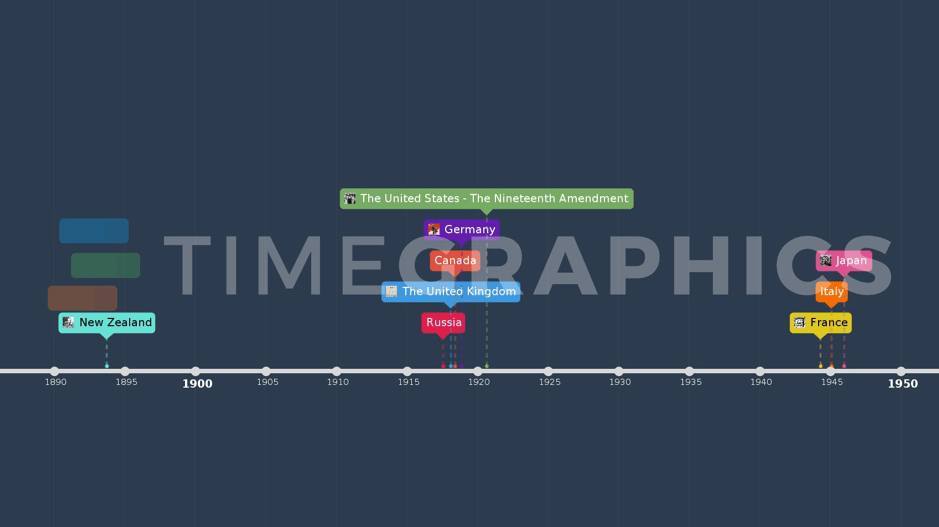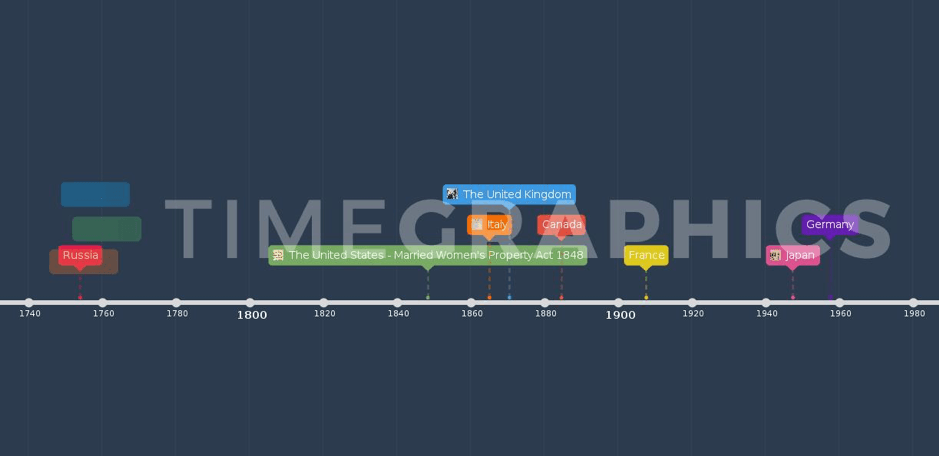Women’s Rights Timeline of G8
In “Woman in the Nineteenth Century”, Margaret Fuller mentions women’s vote right. A fictitious man complains about his wife who is “away from the cradle and the kitchen hearth to vote at polls” (Fuller 876). From this part of her book, I decided to search about America’s development in women’s voting right and compare it with other countries.
This image directly shows the time when each country of G8 gave the right to vote to women. Even though New Zealand is not included in G8, it is the first country which granted suffrage to women, so I added it on the timeline for comparison. On 19 September 1893 the governor signed a new Electoral Act into law; New Zealand became the first self-governing country in the world in which women had the right to vote in parliamentary elections. There is a gap of about 25 years between New Zealand and other countries on the timeline. First of all, the Provisional Government of Russia granted suffrage to women on July 20, 1917. About a year later, the Representation of the People Act granted women over 30 the right to vote in the United Kingdom. Canada women considered as citizens were received the right on 24 May 1918, women considered citizens. Then in 1918, an act by the ‘Council of People’s Deputies’ brought the voting right to German women. Next, the 19th Amendment to the U.S. Constitution gave American women the right to vote and was ratified on August 18, 1920. It is able to say that the United States is one of the countries which gave voting right to women quite early.
There is another gap between America and France: 24 years. The 21 April 1944 ordinance of the French Committee of National Liberation extended the voting right to French women. On 1st February 1945, women suffrage was granted in Italy for the first time and lastly, a December 1945 revision of the Election Law made women to exercise their right to vote in Japan. The women then participated in the April 1946 election, the first general election to be held after the World War II.

https://time.graphics/line/167416
Margaret Fuller also reveals women’s difficult position in the society at that time. She says that women “does not hold property on equal terms with men” (Fuller 877). Therefore, I also made a timeline of women’s property right.
Surprisingly, Russia is the first country which admitted women to have their own properties. In 1753, a decree was issued to assure that noble families could secure their daughter’s inheritance of land by making it a part of the dowry that she would have access to once she was married. The rights of married women from the nobility and merchantry to own and manage their own property offered them an opportunity to become involved in commercial and manufacturing ventures. After 95 years, Married Woman’s Property Act is passed in New York. It is later used as a model for other states, all of which pass their own versions by 1900. For the first time, a woman wasn’t automatically liable for her husband’s debts, she could enter contracts on her own and collect rents or receive an inheritance in her own right.
Italy’s new civil code enacted in 1865 in the aftermath of the Unification, all the women of the country, either they were married or “single”, had the same rights to property as men, including the freedom to make testamentary provisions. The United Kingdom passed the Married Women’s Property Act in 1870. This allowed any money which a woman earned to be treated as her own property, and not her husband’s. After that, Ontario gave married women the right to own property and deal with it and sell it without consulting her husband in 1884, for the first time in Canada. In 1907, a law was passed in France which allowed married women to dispose freely of their own earnings, and after 40 years, Article 24 of Japan’s Constitution states that marriage shall be based only on the mutual consent of both sexes and it included same rights on property. And finally, West Germany’s Basic Law of 1949 insisted “men and women have equal rights”, and this proclamation was implemented in 1957 by the Equal Rights Law which equalized in most respects the mutual rights and duties of husbands and wives and established a new legal regime of marital property, the “community of increase”, a modified system of community property.

https://time.graphics/line/196015
Overall, the United States gave the property right to women in 1848, and granted the suffrage in 1920, 72 years after. Among G8, American women gained their property secondarily, while it took much time to get the suffrage. Fuller’s “Woman in the Nineteenth Century” could have positively affected to the Nineteenth Amendment; it happened three years after Fuller wrote the book.
The Process of my Digital Humanities Project
First of all, I chose “Woman in the Nineteenth Century”, which was written by Margaret Fuller in 1845, as the primary text for my Digital Humanities project. I picked it because Fuller’s writing was impressive. The text was quite difficult to understand to me, but eventually I figured out that there were lots of difficulties to protect women’s rights in America of the nineteenth century. This text made me curious about women’s rights in America. Fuller wrote the text only less than two hundred years ago, but the social status of women was completely different from now. Women were treated as children, or even as slaves. I was surprised with this and felt tempted to find out the process of development in females’ rights in America. I wanted to make some timelines about women’s rights and thought that I would be able to see history of feminism in America from the nineteenth century by the timelines. I also thought that this might explain the effects of “Woman in the Nineteenth Century” to America. Moreover, I expected to compare America’s progress in feminism with other countries and discover that whether America was fast or slow for the development of women’s rights. Even though there are many timelines about women’s rights exist now, it would make some differences with my own timelines with my own classification standards.
Fuller addresses women’s suffrage, property’s right, education and female religious leaders in her writing. At first, I wanted to deal with all of these categories and make four timelines. However, it was really hard to make a solid standard for women’s education and female religious leaders. For example, there are various cases for the implementation of female education. I am able to say the start of female education is the establishment of a female primary school, or high school, or university, or college, or the time when a male school admitted women’s enrollment, and there are also many different types of school as I just mentioned. I decided to look at countries which are belong G8: the United Kingdom, France, Germany, Italy, Canada, Japan and Russia. I chose G8 because they are big countries giving huge effects to the world. Eventually, I tried to make a timeline of women’s education by searching each country’s first female college or university, but some countries in G8 do not have a female college, so I failed to make a timeline with women’s education. It was also difficult to address the category of female religious leaders because there are various different religions in the world. Therefore, I focused on just two categories: women’s voting right and their property right. For women’s suffrage timeline, I searched each country’s biggest and most effective movement which contributed to the change of women’s social status. Most of the events I put on the timeline are implementations of official laws. For the timeline of women’s property right timeline, I concentrated on the time when married women are guaranteed the right to have their own property by law.
I used the site Time Graphics as a tool to make the timelines for this project, which was recommended by Dr. Tippen. It was my first time to use it, but Time Graphics was quite easy to use and the outcomes were also good. The timelines look neat and they are good to see with extension and contraction. It was also easy to attach pictures on the timelines. I could put different colors for the countries and it was helpful for making more effective timelines.
I got to know from the timelines that the United States granted the property right to women quite early, while they gave the voting right not so fast, compared to other G8 countries. I was satisfied with the two final timelines I made because it is comfortable to see and make comparisons between countries. However, If I had more time and a lot of energy, I would think very deeply about establishing clear standards for other categories including the rest of the categories that I gave up. Then I can compare the development in women’s rights in America to other countries more accurately with many other topics.
Doing Digital Humanities project was very new to me and I thought that it is difficult, but as time went by, I started to take an interest in the project. It was a great experience to finish a kind of long project on my own. I learned how to put information that I gathered on a timeline and draw some new information from it.